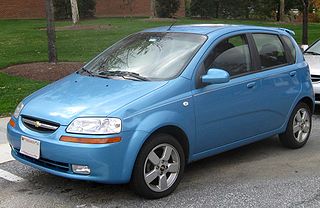Chevrolet Aveo T200 factory workshop and repair manual
 |
This is a browser based program using Javascript. It will run on windows computers within a browser like Firefox or Internet Explorer, as long as Javascript is enabled. Note: File size 200 Mb It is compressed as a zip file which you can extract with 7zip The Chevrolet Aveo T200 was a rebadged Daewoo Kalos introduced in 2002.Also called the Daewoo Gentra, Holden Barina, Chevrolet Lova and Pontiac G3, as well as Pontiac G3 Wave and Suzuki Swift+ . It was maufactured by General Motors. Electrical wiring diagrams cover Left Hand Drive and Right Hand Drive.
Covers the Single overhead cam 1.2 litre, 1.4 litre, 1.5 lite and the Dual overhead cam 1.4 litre engines. It does not cover the 1.6 litre DOHC |
The Chevrolet Aveo (T200) is the very first generation of the Chevrolet Aveo, a subcompact automobile manufactured since 2002 by GM Daewoo, the South Korean subsidiary of General Motors originally marketed as the Daewoo Kalos and prominently marketed as the Aveo. The model received the T200 internal codes, used first by Daewoo, and then, by GM Daewoo during the car's development. The T250 code was designated for the model's facelift. Designed, engineered and originally marketed by GM Daewoo, the Aveo superseded the Daewoo Lanos and was marketed worldwide in 120 countries under five brands (Chevrolet, Daewoo, Holden, Pontiac, and Suzuki). In its home market of South Korea, the T200 was known as Daewoo Kalos, before being rebranded Daewoo Gentra. In several Asian, Australasian, and European export markets, the "Daewoo Kalos" name was also used, only to be afterwards renamed "Chevrolet Aveo" or Holden Barina in the case of Australasia. Other names used consist of Chevrolet Lova in Asia and Pontiac G3 in the United States, selling alongside the "Chevrolet Aveo" version. In Canada, the name Pontiac Wave was initially followed, used by Pontiac G3 Wave, before adopting the "Pontiac G3" name used in the United States. Since 2003, Suzuki has also available a adaptation in Canada as the Suzuki Swift+ alongside the Chevrolet and Pontiac badged versions. T200's successor, the T300 was released in 2011. The Swift+ was dropped after the 2011 model year due to poor earnings along with the whole Suzuki brand, although Suzuki Canada lists 2010 as the final model year Swift+. The Daewoo Kalos was introduced in 2002, based on a then-new Daewoo platform named T200, replacing the Daewoo Lanos (T100). Under development before Daewoo's bankruptcy, the Kalos was the company's first new model introduction following its subsequent takeover by General Motors. Manufacture of the Kalos began in early March, 2002, with pre-production prototypes shown at the Geneva Auto Show in April 2002. The nameplate Kalos derives from the Greek word for "beautiful" and "good".Designed by Italdesign, the Kalos derives directly from the Kalos fancy concept vehicle first presented at the 2000 Paris Motor Show and subsequent developmental concepts at the 2001 Frankfurt Motor Show, 2002 Geneva Auto Show, and 2003 at the Geneva Show. During this three-year programming period Daewoo had been struggling financially, with the ultimate fate of the company and the concept vehicle remaining uncertain. Two different T200 front-end styling designs were available. Whenever released in 2002, the T200 headlamps were detached from the horizontal amber turn alert strip, located directly below. This detached style, utilized mainly in South Korea and North America, was used in conjunction with a semi-elliptical grille. When sales in Europe began in 2003, the headlights were an integrated unit that slanted upwards from the "V-shaped" grille towards the front fenders. In Australia, whenever the Daewoo Kalos was introduced in 2003, the hatchback featured the integrated lighting arrangement, with the detached style used to differentiate the sedans. In South Korea, in which the detached lights were used at first, the integrated design was later utilized as a facelift. The T200 sedan and five-door hatchback featured a swage line working along the lower body to the rear door, which kinks down prominently on the five-door. Five-doors additionally feature a side window in the C/D pillar with a distinctively angled lower edge. Interiors feature a circular motif throughout. Upon introduction the initial European models carried an emblem reading "Design Giugiaro." Referring to his firm's design of the Kalos, Giorgetto Giugiaro replied: "When we designed it, you set out to produce an alternative to conventional lines and tread new ways in terms of design." The Kalos was sold in three available body styles: a 4-door sedan and 5-door hatchback from the beginning of production in 2002, and a 3-door hatchback available in some European markets beginning in 2005. All body styles meet North American subcompact and European B-segment or supermini size classifications. The interior amount was 102.7 cu ft (2,910 L) (5-door) and 107.4 cu ft (3,040 L) (sedan) according to the EPA, meeting the minimum criterion for a compact vehicle despite being advertised as a sub-compact. Headroom was unmatched in their class at the time of its introduction. Per the German Verband der Automobilindustrie (VDA) standard, 5-door hatchbacks featured 175 litres (6.2 cu ft) of cargo area with the rear seats in their upright positions and 735 litres (26.0 cu ft) with the rear seats folded down, with a maximum payload rating of 495 kg (1,091 lb). Per U.S. Ecological Protection Agency (EPA) ratings, the 5-door hatchbacks featured cargo volume of 11.7 cubic feet (330 L) (rear seats up) to 42 cu ft (1,200 L) (back seats down), with 7.1 cu ft (200 L) available in the sedan. Chevrolet Aveo Factory workshop and repair manual 2002 - 2011 2003 2004 2005 2006 2007 2008 2009 2010

 0 Items (Empty)
0 Items (Empty)